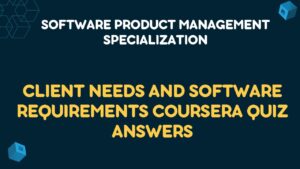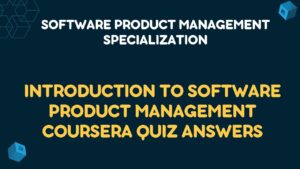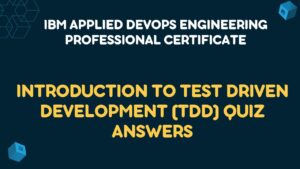Table of Contents
Introduction to Agile Development and Scrum Week 01 Quiz Answers
Q1. Which answer is valued and emphasized in Agile?
- Adaptive planning and early delivery
- Adhering to the scope of work
- Using the most up-to-date tools and processes
- Comprehensive documentation
Q2. How is the waterfall method different from Agile?
- Agile has architects, developers, and testers working in separate phases.
- Agile emphasizes upfront gathering of requirements and documentation.
- The waterfall method has phases so that when one ends, the next begins.
- The waterfall method moves faster than Agile.
Q3. Which of these software development approaches comes from lean manufacturing and has to do with visualizing work?
- Extreme Programming
- Agile
- Waterfall
- Kanban
Q4. Which answer is consistent with working in small batches? (Assume that you have 50 boards to sand and paint.)
- Sand and paint 10 boards. Check quality and deliver these. Then move to the next 10, and so on.
- Sand and paint all the boards and check quality. Put them in bundles of 10 and deliver.
- Sand the boards 10 at a time, then paint them 10 at a time. Check quality and deliver.
- Sand all the boards and check quality. Paint all of them and deliver.
Q5. What is a minimum viable product (MVP)?
- A focus on delivery and product completion
- The cheapest and easiest thing you can build to test your value hypothesis
- The result of each phase of a project
- Determining up front what the customer wants
Q6. In Scrum, who determines priorities and how work is accomplished?
- The scrum team negotiates commitments with the product manager and has authority on how to reach commitments.
- The customer determines priorities and how the work is carried out.
- The scrum master reprioritizes the backlog and directs the team.
- The project owner directs how and when work will be done, and which team members will do it.
Q7. How is Scrum different from Kanban?
- Scrum has roles, such as scrum master, while Kanban does not have existing roles.
- Scrum key metrics are focused on cycle time, while Kanban emphasizes velocity.
- Scrum has long sprints, while Kanban has short sprints.
- Scrum is more flexible regarding change, while Kanban is more structured.
Q8. Choose the correct statement regarding organizing your teams.
- Teams are tightly coupled and loosely aligned.
- Each team’s mission should be aligned with their professional goals.
- Teams have end-to-end responsibility for what they build.
- The long-term mission is typically around several business domains.
Q9. Select the correct statement regarding team autonomy.
- Decisions happen locally on the team level.
- Teams get bogged down making decisions.
- Bottlenecks are avoided by having upper level management make decisions.
- Autonomy allows management to push teams harder.
Q10. Which of the following descriptions of Agile is correct?
- It is a new version of waterfall with sprints.
- It is responsive to changes and delivers value.
- It is similar to waterfall, but with Scrum added.
- It is a type of project management, led by a project manager.
Introduction to Agile Development and Scrum Week 02 Quiz Answers
Q1. Select the key problem with having a traditional product manager who becomes a product owner.
- The product owner must stay focused on the stakeholders rather than the team.
- The product owner must stay focused on the budget.
- The product owner must be able to focus on vision over operations.
- The product owner must be able to focus on business requirements over technical goals.
Q2. Select the correct statement regarding the scrum master.
- The scrum master keeps the team marching to a fixed plan.
- The scrum master is a coach rather than a task master.
- The scrum master documents impediments as project risks.
- The scrum master is a role based on the waterfall approach.
Q3. Select the correct statement regarding kanban pipelines.
- The new issues pipeline is for storing items you will do in the next two weeks.
- The first pipeline on a kanban board is product backlog.
- The sprint backlog is followed by the icebox.
- A kanban board is made of multiple pipelines.
Q4. What happens to sticky notes on a kanban board?
- They are used as messages from one team member to another.
- They are moved across the board to show progress.
- They stay put until the story is finished.
- They are removed as tasks are completed.
Q5. The parts of a user story are: As a _____, I need _____, so that _____.
- user, assumption, goal
- role, function, benefit
- benefit, detail, outcome
- direction, idea, outcome
Q6. INVEST says stories should be _____.
- short
- visionary
- independent
- dependent
Q7. Select the correct statement regarding product backlog.
- Epic stories are automatically put first in the product backlog.
- The stories at the bottom of the backlog are the most detailed.
- The product backlog is ordered by which stories follow the template.
- The product backlog is ordered by importance.
Q8. Select the correct statement regarding backlog refinement.
- The product owner provides estimates and technical information.
- The team sorts the product backlog in order of importance.
- The goal is to put most of the stories in the icebox or reject them.
- Large, vague items are split into smaller stories and clarified.
Q9. Who has the key role at the backlog refinement meeting?
- The scrum master has the key role of technical assistance.
- The product owner has the key role of refining the backlog.
- The development team has the key role of refining the backlog.
- The lead architect has the key role of technical assistance.
Q10. What is velocity in terms of sprint planning?
- The speed at which every team should be able to work.
- A measure of how quickly the team can plan a sprint.
- Each team has a measure of how quickly they work, for comparison.
- The number of story points a team can complete in a single sprint.
Introduction to Agile Development and Scrum Week 03 Quiz Answers
Q1. How does a developer choose stories from the sprint backlog?
- You take one or two stories.
- You take stories until you are blocked.
- You take a story based on your preference.
- You take the next highest priority story.
Q2. How does the daily stand-up serve the team?
- The product owner can find out what team members are working on.
- The team members can find out who is working on what.
- The team members can find solutions to blocks.
- The scrum master can find out the team’s plans for the week.
Q3. What does each team member discuss in the stand-up?
- What did I work on yesterday, what am I working on today, and are there any blocks?
- What is my plan to resolve my blocks and impediments?
- What stories are still in my backlog and when can I start them?
- What is our current status against our sprint goal?
Q4. You measure story points completed vs. story points remaining for a sprint using a _____ chart.
- Workflow
- Timeboxing
- Burndown
- Kanban
Q5. What is a sprint review?
- A status meeting
- A development team peer-to-peer meeting
- A live demonstration meeting
- A problem review meeting
Q6. Are customers invited to the sprint review?
- Yes. The development team, product owner, scrum master, stakeholders, and customers are invited to participate.
- No. Only the development team and the scrum master participate.
- No. Only the development team, the scrum master, and the product owner participate.
- Yes. The product owner and scrum master meet with the customer.
Q7. Select the correct statement regarding the sprint retrospective.
- It is an opportunity for the product owner to give the team feedback.
- It is an opportunity for team members to reflect on the sprint and speak freely about it.
- It is an opportunity for the scrum master to evaluate the team.
- It is an opportunity for the team to reflect on the scope of the project.
Q8. Which of the following is a key question to ask during the sprint retrospective?
- What is our team’s story point average?
- Do we have healthy team members?
- How can we maintain our velocity going forward?
- What should we change going forward?
Q8. Which of these metrics measure how long it takes from idea to production?
- Mean lead time
- Mean time to recover from change
- Release frequency
- Change failure rate
Q10. Select the statement that describes an end of sprint activity.
- Move stories from the done column to the closed column.
- Move unfinished stories to the next sprint.
- Adjust your current milestone and your velocity charts.
- Give developers credit for finished stories, but not for unfinished stories.
Get All Course Quiz Answers of Entrepreneurship Specialization
Entrepreneurship 1: Developing the Opportunity Quiz Answers
Entrepreneurship 2: Launching your Start-Up Quiz Answers
Entrepreneurship 3: Growth Strategies Coursera Quiz Answers
Entrepreneurship 4: Financing and Profitability Quiz Answers




